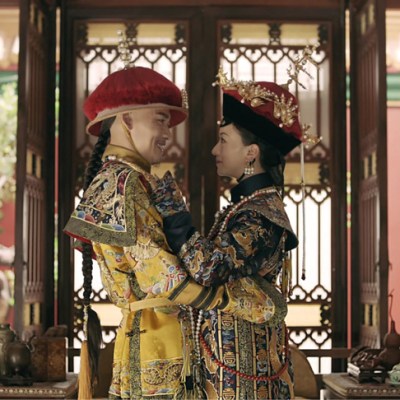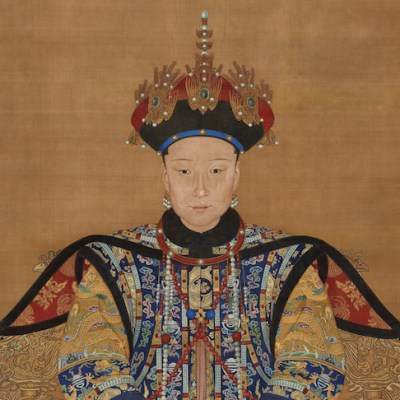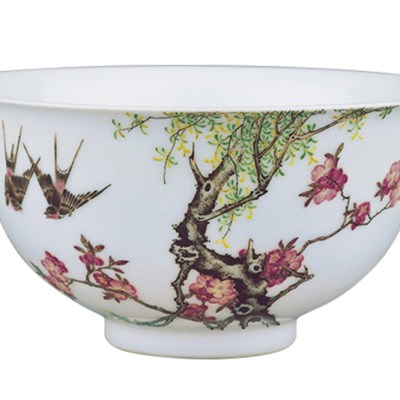From the November 2023 issue of Apollo. Preview and subscribe here.
This scroll from 17th-century China is as remarkable for its length – more than 29.3m – as for the level of detail in its painting. The Kangxi Emperor’s Southern Inspection Tour, 1689, Scroll 7: Wuxi to Suzhou (1691–98) offers a panoramic view of the urban and rural life of the Jiangnan region in the Yangtze River delta – featuring the emperor himself, right down to children playing in the street and a donkey scratching its back.
The scroll depicts the emperor’s route from Wuxi to Suzhou, cities that lay about 50 kilometres apart. Starting from the right, it begins with mountains, hills and rivers. Then come small riverboats, cargo ships and bustling canalside streets. There are well-known landmarks, such as Tiger Hill in Suzhou, topped by the Yunyan Pagoda – a famous tourist site to this day. Next, we see Suzhou’s Chang Gate, where the emperor and his entourage are about to disembark from a boat.
Spectators and officials await him, kneeling. The streets are lined with crowds and decorated for the occasion with paper flowers and silk ribbons. A red carpet is laid out; the emperor’s white stallion is waiting at one side. Once on shore, the Kangxi Emperor would mount his horse to ride through the bustling streets of Suzhou. He had ordered ‘business as usual’ to continue during his visit – the shops were kept open and the people remained busy. Near the very end of the scroll is the Suzhou Imperial Weaving Agency: an important site, as the city was a centre of silk making.
The Kangxi Emperor’s Southern Inspection Tour, 1689, Scroll 7: Wuxi to Suzhou (detail; 1691–98), Wang Hui (1632–1717). Mactaggart Art Collection, University of Alberta Museums

In the 1690s, the Kangxi Emperor commissioned a set of handscroll paintings to record his tours into the south, of which this painting is one. This is the seventh in a set of 12 scrolls depicting his official tour of 1689, his second such journey. The travels were meticulously recorded in written form and later documented on long silk panels in ink and mineral colours – the hues are still vibrant. Only a few dozen such scrolls exist, most of which are in the Beijing Palace Museum. This example, from the Mactaggart Art Collection in the University of Alberta Art Museums in Canada, is rarely exhibited, owing to the fragility of the scroll and its sensitivity to light.
The creation of this handscroll was led by Wang Hui: a court artist who came from the region and who was a great master of landscape painting. He was commissioned by the emperor to supervise the production of these scrolls. Wang supervised a whole team of assistants, and the sketches he had drafted initially on paper needed imperial approval before they could be transferred on the silk panels. By the time this scroll was made, Jesuit missionaries had spent some time in the Chinese court and court artists had begun to adopt Western-style approaches to perspective, using a vanishing point. European pictures known in China at the time may have had an effect on the sense of perspective, space and depth that can be perceived in these paintings. Think, for instance, of the Italian Jesuit missionary and painter Giuseppe Castiglione, who was a court artist under three emperors. He was employed by the Kangxi Emperor and still served under his son and eventually his grandson, the Qianlong Emperor.
The handscroll on display in the Cleveland Museum of Art’s exhibition shows an idealised version of what the rural and urban environment would have looked like. It can be understood as a propaganda piece, designed to illustrate the prosperity of the empire under a wise, caring ruler, as well as a court document made to commemorate the emperor’s travels. He travelled via the Grand Canal, an artificial waterway that, over thousands of kilometres, connected the city of Beijing with the wealthy, historic cities in the Lower Yangtze delta, such as Yangzhou, Hangzhou and Suzhou.
The scroll shows a prospering empire and thousands of figures crowding the streets, canals and fields, engaged in agricultural activities, selling and buying goods, or just watching an opera performed on a private boat. These are scenes one can encounter even today. The region’s wealth and prospering economy is indicated by the little stalls and shops that offer artisanal goods and daily necessities. For instance, dyed panels of cottons and silks in various colours are hung outside textile workshops. A courtyard filled with bonsai trees indicates the existence of private gardens in residences lying behind the walls of the narrow alleys and streets. Antiques shops can be seen alongside those offering fish, rice and meat.
The Kangxi Emperor’s Southern Inspection Tour, 1689, Scroll 7: Wuxi to Suzhou (detail; 1691–98), Wang Hui (1632–1717). Mactaggart Art Collection, University of Alberta Museums

Outside the city, women gather mulberry leaves from trees to feed the silkworms and farmers are ploughing their fields with water buffaloes. Agriculture was the foundation of the empire and the important role of farming and sericulture was emphasised in written and visual statements, such as this.
While these paintings depict an idealised world, they give us a very good image of what daily life was like during these times – to the point that later versions of these paintings even show shop signs, such as Qianzhuang (private bank); Yusan hang (umbrella store); Zhe hang (sugarcane store). A certain idealisation can be seen in the fact that the painting conveys a spring-like atmosphere. There are passages of the cityscapes that are shrouded in layers of mists – as in the early morning hours, when the air was considered to be filled with auspicious energy.
Back in 1644, after nearly three centuries of imperial rule, the Ming dynasty had fallen due to floods, droughts and rebellions. The invading Manchus (from Manchuria in the north-east of China) took over the government in Beijing, establishing themselves as the Qing dynasty. While the Ming dynasty had been a native government, now there were foreigners on the throne. The first emperors therefore met with considerable resistance from the population throughout the first decades of Qing rule. One of the centres of resistance was the Yangtze delta in the south-east, home to many educated and wealthy families whose members had served at court. This region was also a hub for trade and a centre of silk and rice production within the empire. About a third of the country’s annual tribute revenue was generated in this region and it was paid in part in the form of rice and silk.
From 1684 onwards, the Qing dynasty’s Kangxi Emperor made six Southern Inspection Tours from Beijing via the Grand Canal to the south, visiting historic sites, familiarising himself with local customs and examining water management systems. These tours were also designed to make his presence known – he would talk to people at all levels of society.
Southern Inspection Tours were enormous enterprises – very costly and time consuming – but they were worthwhile. Their illustrations in sets of scrolls give us a vivid picture of the time and of specific places. The tours are also evidence that both the Kangxi and Qianlong Emperors recognised the importance of the Lower Yangtze delta to maintaining the peace, prosperity and unity of the empire. In other words, the loss of the trust of the Jiangnan citizens – and the wealth and income the region generated for the throne – would have put the whole empire at risk. The inspection tour scrolls documented the emperor’s presence in the region and reaffirmed his rulership over Jiangnan.
As told to Isabella Smith.
Clarissa von Spee is curator of Chinese art and chair of Asian art at the Cleveland Museum of Art.
‘China’s Southern Paradise: Treasures from the Lower Yangzi Delta’ is at the Cleveland Museum of Art until 7 January 2024.
From the November 2023 issue of Apollo. Preview and subscribe here.


